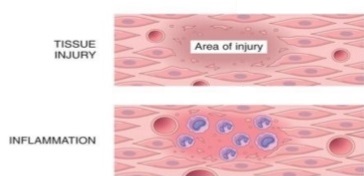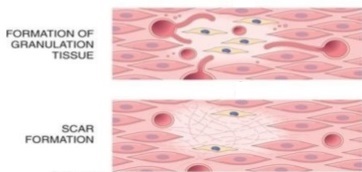Sustained an injury? Unsure whether to use hot or cold? When can I go back to activity?
If you have asked yourself these questions, read on. In this post I will briefly explain the stages of the healing process and how this relates to the type and intensity of treatment provided or recommended. The healing process is an extremely complex process and here we have provided a relevant account with regards to the treatment proposed at each stage. We have by no means attempted to include all the stages and actions of the healing process. This is an overview of relevant points with regards to the planning and reasoning of certain treatment types.
At the initial time of injury, an inflammatory response starts. The initial stage of the healing process is the inflammatory stage, where the tissue fibres are disrupted or damaged. This results in swelling, bleeding and the presence of debris from tissue damage. Specific cells known as phagocytes (Cell eating) or white blood cells clear and clean the area from the clotting blood and the tissue debris.

Treatment
Do`s – Protect, Rest, ICE, Compress, Elevate. (P.R.I.C.E.)
Dont`s – Deep tissue massage, Heat.
The aim of treatment at this stage is to reduce or stop bleeding from ruptured tissue and to reduce the severity of the inflammatory response. To do this we must follow the PRICE guidelines. Protecting and resting the area helps to stop excessive blood flow and reduce the potential bruising and swelling response. ICE also helps to reduce blood flow by causing the blood vessels to close (Vasoconstriction). Compression and elevation help with the flow of the lymphatic system so the phagocytes can easily transport and remove the clotting blood and cell / fibre debris.
The next phase of the healing process is known as proliferation.
Blood platelets help the blood to clot and provides the basic meshwork of fibres (Scar tissue) for tissue to bond to and grow. Cells known as Fibroblast (Cell builders) create delicate bonds (Hydrogen bonds) between collagen fibres and specific cells build specific types of fibres. For example a Myo fibroblast builds muscle fibre.

Treatment
Do`s – Gentle movement of the affected area, gentle stretching both as home exercises and in physical treatment. Strength and conditioning programme with static or low resistance exercises. Deeper massage can now commence but this is graded by the therapist, too deep will cause too much blood flow – not deep enough will not facilitate the required response.
Dont`s – Over load the area, this will break the delicate bonds formed and will lead to an increase in inflammation, further bleeding and potential scar tissue formation. Slowing and even reversing the healing process.
The final phase of the healing process is known as the Maturation phase / Remodelling phase.
Collagen fibres form strong (Covalent) bonds. This increases the tensile strength of the tissue and injured areas. Normal tissue is formed according to the type of tissue injured and if the healing process has been allowed to continue uninterrupted by activity or re injury, the tissue will heal correctly. With specific guidance and exercise the fibres form the correct type of fibres in the correct order and position to return the structure to a normal state. If this is not achieved, the scar tissue will strengthen and can lead to adhesion and permanent restriction.

Treatment
Do`s – Begin load bearing strength exercises, progression of the strength programme deep tissue and friction massage.
Dont`s – Do not stop rehabilitation! Typically when someone feels better, the exercises stop. It is this that will lead and leave someone open to re-injury. If the healing process is not completed, the tissue will remain weak, fragile and vulnerable.
In the final stage of healing the tissue fibres need to be manipulated in such a way that the fibres of the tissue are organised correctly so that they can “slide” over one another. If the fibres do not have this flexible ability, they are more vulnerable to injury and more severe inflammatory responses if re injured.
If you have an injury that is not healing or improving give us a call to book an appointment or for a free telephone consultation.
Finally – please note that the information in this blog is not intended as a substitute for specific advice for your particular problem. Each injury needs to be assessed and treated as per the stage of the healing process and the stage of the injury.



